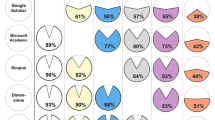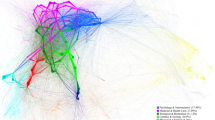Abstract
The intention of this work is to analyze top scientists’ collaboration behavior at the “international”, “domestic extramural” and “intramural” levels, and compare it to that of their lesser performing colleagues. The field of observation consists of the entire faculty of the Italian academic system, and so the coauthorship of scientific publications by over 12,000 professors. The broader aim is to improve understanding of the causal nexus between research collaboration and performance. The analysis is thus longitudinal, over two successive five-year periods. Results show a strong increase in the propensity to collaborate at domestic level (both extramural and intramural), however this is less for scientists who remain or become top, than it is for their lower-performing colleagues. In contrast, the increase in international collaboration behavior is greater for scientists who become or remain top than it is for their peers. The increase in productivity by those who acquire top scientist status is due precisely to the greater average impact of the publications achieved in collaboration with foreign colleagues.


Similar content being viewed by others
Notes
The complete list is accessible at http://attiministeriali.miur.it/UserFiles/115.htm, last accessed October 25, 2018.
http://cercauniversita.cineca.it/php5/docenti/cerca.php, last accessed October 25, 2018.
The analysis omits the SDSs where over 50% of professors have no publications indexed in the WoS, over the period of observation.
Refer to Abramo (2018) for a thorough discussion about the definition and bibliometric measurement of impact.
Similar indicators are presented by Martín-Sempere, Garzón-Garcia and Rey-Rocha (2008) and Ductor (2015).
Note that the percentages of No–Yes TSs and Yes–No TSs do not coincide because TSs are the top productive professors in the overall population (larger than the dataset under analysis).
The analysis does not include UDAs 11 and 13 (Pedagogy and psychology; Economics and statistics), given the low number of observations in some classes of collaboration.
With reference to equation [1].
References
Abramo, G. (2018). Revisiting the scientometric conceptualization of impact and its measurement. Journal of Informetrics, 12(3), 590–597.
Abramo, G., Cicero, T., & D’Angelo, C. A. (2011a). Assessing the varying level of impact measurement accuracy as a function of the citation window length. Journal of Informetrics, 5(4), 659–667.
Abramo, G., Cicero, T., & D’Angelo, C. A. (2013a). Individual research performance: a proposal for comparing apples to oranges. Journal of Informetrics, 7(2), 528–539.
Abramo, G., & D’Angelo, C. A. (2007). Measuring science: Irresistible temptations, easy shortcuts and dangerous consequences. Current Science, 93(6), 762–766.
Abramo, G., & D’Angelo, C. A. (2014). How do you define and measure research productivity? Scientometrics, 101(2), 1129–1144.
Abramo, G., D’Angelo, C. A., & Caprasecca, A. (2009). Gender differences in research productivity: A bibliometric analysis of the Italian academic system. Scientometrics, 79(3), 517–539.
Abramo, G., D’Angelo, C. A., & Murgia, G. (2013b). The collaboration behaviors of scientists in Italy: a field level analysis. Journal of Informetrics, 7(2), 442–454.
Abramo, G., D’Angelo, C. A., & Murgia, G. (2013c). Gender differences in research collaboration. Journal of Informetrics, 7(4), 811–822.
Abramo, G., D’Angelo, C. A., & Murgia, G. (2014). Variation in research collaboration patterns across academic ranks. Scientometrics, 98(3), 2275–2294.
Abramo, G., D’Angelo, C. A., & Murgia, G. (2017). The relationship among research productivity, research collaboration, and their determinants. Journal of Informetrics, 11(4), 1016–1030.
Abramo, G., D’Angelo, C. A., & Solazzi, M. (2011b). Are researchers that collaborate more at the international level top performers? An investigation on the italian university system. Journal of Informetrics, 5(1), 204–213.
Abt, H. A. (2007). The future of single-authored papers. Scientometrics, 73(3), 353–358.
Ackers, L. (2004). Managing relationships in peripatetic careers: Scientific mobility in the European Union. Women’s Studies International Forum, 27(3), 189–201.
Ackers, L. (2005). Moving people and knowledge: Scientific mobility in the European Union. International Migration, 43(5), 99–131.
Aldieri, L., Kotsemir, M., & Vinci, C. P. (2017). The impact of research collaboration on academic performance: An empirical analysis for Some European countries. Socio-Economic Planning Sciences, 62(C), 13–30.
Archambault, É., Vignola-Gagné, É., Côté, G., Larivière, V., & Gingras, Y. (2006). Benchmarking scientific output in the social sciences and humanities: The limits of existing databases. Scientometrics, 68(3), 329–342.
Arthur, N., Patton, W., & Giancarlo, C. (2007). International project participation by women academics. Canadian Journal of Education, 30(1), 323–348.
Bozeman, B., & Boardman, C. (2014). Research collaboration and team science. Cham: Springer International Publishing.
Bozeman, B., & Corley, E. (2004). Scientists’ collaboration strategies: Implications for scientific and technical human capital. Research Policy, 33(4), 599–616.
Bozeman, B., Dietz, J., & Gaughan, M. (2001). Scientific and technical human capital: An alternative model for research evaluation. International Journal of Technology Management, 22(8), 716–740.
Bozeman, B., & Gaughan, M. (2011). How do men and women differ in research collaborations? An analysis of the collaborative motives and strategies of academic researchers. Research Policy, 40(10), 1393–1402.
Carillo, M. R., Papagni, E., & Sapio, A. (2013). Do collaborations enhance the high-quality output of scientific institutions? Evidence from the Italian research assessment exercise. Journal of Behavioral and Experimental Economics, 47(C), 25–36.
Cronin, B. (2001). Hyperauthorship: A postmodern perversion or evidence of a structural shift in scholarly communication practices? Journal of the American Society for Information Science and Technology, 52(7), 558–569.
D’Angelo, C. A., Abramo, G. (2015). Publication rates in 192 research fields. In A. Salah, Y. Tonta, A. A. A. Salah, C. Sugimoto (Eds.) Proceedings of the 15th International Society of Scientometrics and Informetrics Conference—(ISSI-2015) (pp. 909–919). Istanbul: Bogazici University Printhouse.
Ductor, L. (2015). Does co-authorship lead to higher academic productivity? Oxford Bulletin of Economics and Statistics, 77(3), 385–407.
Frehill, L. M., Vlaicu, S., Zippel, K. (2010). International scientific collaboration: Findings from a study of NSF principal investigators. Technical report, National Science Foundation.
Fuchs, S., Von Stebut, J., & Allmendinger, J. (2001). Gender, science, and scientific organizations in Germany. Minerva, 39(2), 175–201.
Gaughan, M., & Bozeman, B. (2016). Using the prisms of gender and rank to interpret research collaboration power dynamics. Social Studies of Science, 46(4), 536–558.
Gazni, A., Sugimoto, C. R., & Didegah, F. (2012). Mapping world scientific collaboration: Authors, institutions, and countries. Journal of the American Society for Information Science and Technology, 63(2), 323–335.
Hicks, D. (1999). The difficulty of achieving full coverage of international social science literature and the bibliometric consequences. Scientometrics, 44(2), 193–215.
Hinnant, C. C., Stvilia, B., Wu, S., Worrall, A., Burnett, G., Burnett, K., et al. (2012). Author-team diversity and the impact of scientific publications: Evidence from physics research at a national science lab. Library and Information Science Research, 34(4), 249–257.
Jha, Y., & Welch, E. W. (2010). Relational mechanisms governing multifaceted collaborative behavior of academic scientists in six fields of science and engineering. Research Policy, 39(9), 1174–1184.
Katz, J. S., & Hicks, D. (1997). How much is a collaboration worth? A calibrated bibliometric model. Scientometrics, 40(3), 541–554.
Katz, J. S., & Martin, B. R. (1997). What is research collaboration? Research Policy, 26(1), 1–18.
Kyvik, S., & Olsen, T. B. (2008). Does the aging of tenured academic staff affect the research performance of universities? Scientometrics, 76(3), 439–455.
Larivière, V., Gingras, Y., Sugimoto, C. R., & Tsou, A. (2015). Team size matters: Collaboration and scientific impact since 1900. Journal of the Association for Information Science and Technology, 66(7), 1323–1332.
Larivière, V., Vignola-Gagné, E., Villeneuve, C., Gélinas, P., & Gingras, Y. (2011). Sex differences in research funding, productivity and impact: An analysis of Québec university professors. Scientometrics, 87(3), 483–498.
Leahey, E. (2016). From sole investigator to team scientist: Trends in the practice and study of research collaboration. Annual Review of Sociology, 42(1), 81–100.
Lee, S., & Bozeman, B. (2005). The impact of research collaboration on scientific productivity. Social Studies of Science, 35(5), 673–702.
Liao, C. H. (2011). How to improve research quality? Examining the impacts of collaboration intensity and member diversity in collaboration networks. Scientometrics, 86(3), 747–761.
Long, J. S. (1990). The origins of sex differences in science. Social Forces, 68(4), 1297.
Martín-Sempere, M. J., Garzón-García, B., & Rey-Rocha, J. (2008). Team consolidation, social integration and scientists’ research performance: An empirical study in the Biology and Biomedicine field. Scientometrics, 76(3), 457–482.
Mauleón, E., & Bordons, M. (2006). Productivity, impact and publication habits by gender in the area of Materials Science. Scientometrics, 66(1), 199–218.
Melin, G., & Persson, O. (1996). Studying research collaboration using co-authorships. Scientometrics, 36(3), 363–377.
Melkers, J., & Kiopa, A. (2010). The social capital of global ties in science: The added value of international collaboration. Review of Policy Research, 27(4), 389–414.
Powell, W. W., White, D. R., Koput, K. W., & Owen-Smith, J. (2005). Network dynamics and field evolution: The growth of interorganizational collaboration in the life sciences. American Journal of Sociology, 110(4), 1132–1205.
Rawlings, C. M., & McFarland, D. A. (2011). Influence flows in the academy: Using affiliation networks to assess peer effects among researchers. Social Science Research, 40(3), 1001–1017.
Rhoten, D., & Pfirman, S. (2007). Women in interdisciplinary science: Exploring preferences and consequences. Research Policy, 36(1), 56–75.
Sonnert, G., & Holton, G. J. (1995). Gender differences in science careers: The project access study. Rutgers: Rutgers University Press.
Uddin, S., Hossain, L., Abbasi, A., & Rasmussen, K. (2012). Trend and efficiency analysis of co-authorship network. Scientometrics, 90(2), 687–699.
van Rijnsoever, F. J., Hessels, L. K., & Vandeberg, R. L. J. (2008). A resource-based view on the interactions of university researchers. Research Policy, 37(8), 1255–1266.
Wuchty, S., Jones, B. F., & Uzzi, B. (2007). The increasing dominance of teams in production of knowledge. Science, 316(5827), 1036–1039.
Yoshikane, F., & Kageura, K. (2004). Comparative analysis of coauthorship networks of different domains: The growth and change of networks. Scientometrics, 60(3), 435–446.
Zhang, C., Bu, Y., Ding, Y., & Xu, J. (2018). Understanding scientific collaboration: Homophily, transitivity, and preferential attachment. Journal of the Association for Information Science and Technology, 69(1), 72–86.
Author information
Authors and Affiliations
Corresponding author
Rights and permissions
About this article
Cite this article
Abramo, G., D’Angelo, C.A. & Di Costa, F. The collaboration behavior of top scientists. Scientometrics 118, 215–232 (2019). https://doi.org/10.1007/s11192-018-2970-9
Received:
Published:
Issue Date:
DOI: https://doi.org/10.1007/s11192-018-2970-9




